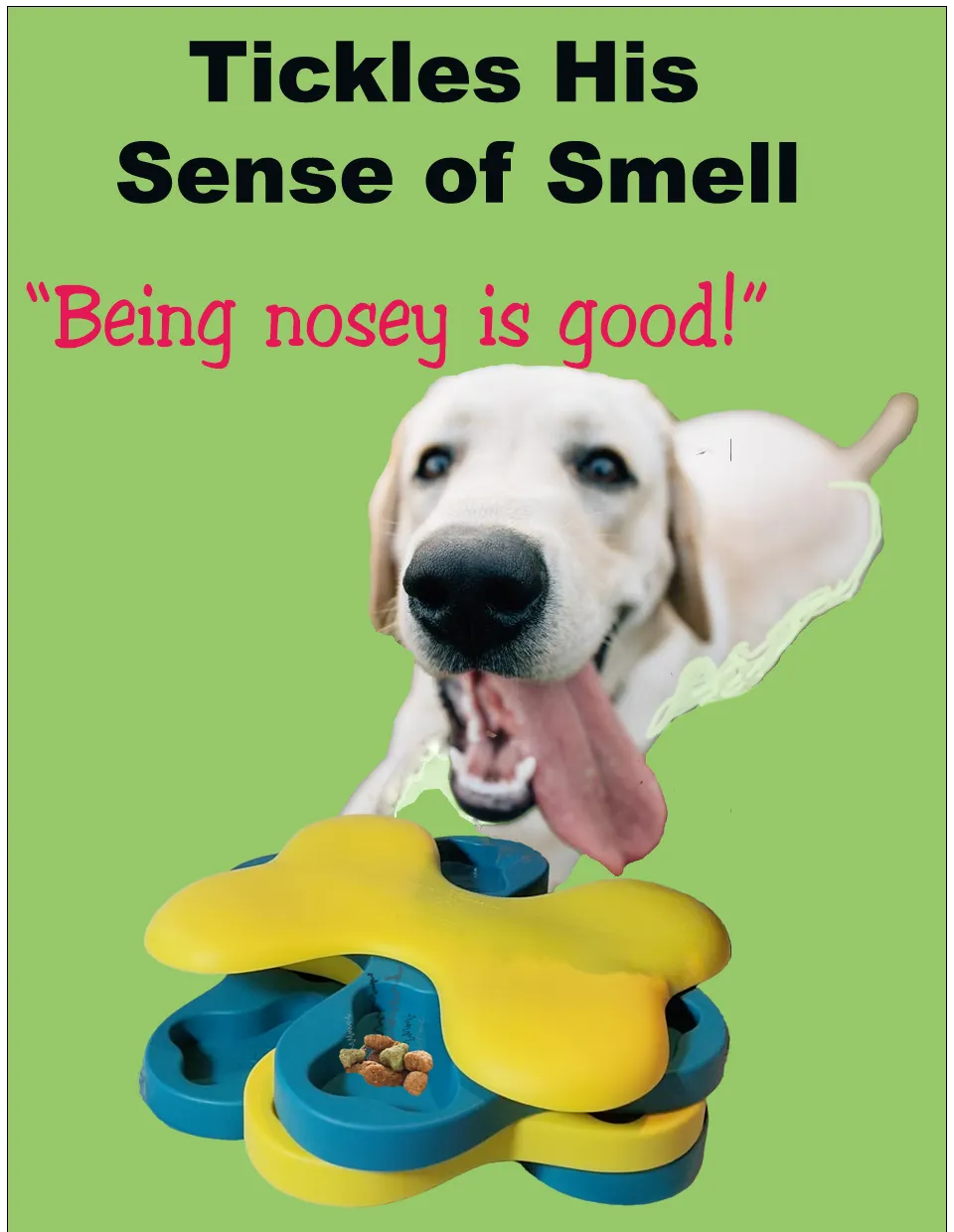Frequently-Asked Questions About Safe Puzzle Dog Toys

- Should I be aware of safety concerns with my dog’s toys?
Answer: It is possible for a dog’s toy to be hazardous to your pet’s health, in more than one way. If the toy is not well made, it could be vulnerable to coming apart. Small pieces might present a choking hazard or cause intestinal blockage or perforation. You may want to avoid toys with parts that look easy to pull off. This can be more serious for a puppy.
There are also endocrine-disrupting chemicals (EDC’s), which means that they can alter hormones. EDC’s include BPA, BPS and BPF (bisphenol A or S or F). There are many other EDC’s in plastic products, some still unidentified. These contaminants are a source of concern for adults, children, and pets.
Some dog toy manufacturers label their products as “non-toxic” or specifically “BPA-free”.
2. What are some of the dangerous contaminants to avoid in dog toys?
Answer: Below is a list of potential contaminants:
- PVC: Polyvinyl chloride (PVC) by itself is generally not dangerous to dogs, but manufacturers often use toxic chemical additives to make the PVC more soft and flexible.
- Phthalates: An additive often used in PVC products. Over time, they can leach out and absorb through the skin (like your dog’s gums) and cause damage to their liver and kidneys.
- BPA: Bisphenol A is an endocrine-disrupting chemical and “the presence of BPA in dogs was associated with changes to their gut microbiome and metabolism,” according to Time.
- Lead: Can damage multiple organs, including the nervous system and gastrointestinal tract. Signs of lead poisoning in dogs might include a lack of appetite, diarrhea, constipation, anxiety, hysterical barking, jaw champing (rapid clenching), salivation, blindness, lack of coordination, or muscle spasms. Note that some brands of tennis balls have had lead contamination problems in the past. Avoid the tennis ball brands mentioned here.
- Chromium: Though chromium has been used as an insulin supplement2 for dogs (among other uses) high enough levels can be toxic and have been shown to cause cancer in humans3.
- Melamine: Has been linked with kidney failure from pet foods that were recalled due to the presence of melamine.
- Arsenic: Heavy metal mineral that can lead to symptoms such as vomiting and loss of consciousness, and even death in extreme doses.
- Bromine: A chemical often used as a pet-safer alternative to chlorine in pools, but it can cause digestive upset and changes to urination.
- Formaldehyde: Formaldehyde is commonly used to preserve chews such as rawhides. With long-term exposure or high enough doses, it could cause problems for dogs, including possible respiratory or digestive irritation.
3. Do the fillings contain ingredients that are safe for dogs?
Answer: The fact must be repeated that, although plush toys made for dogs should be extra durable material and double-stitched, they are not designed to withstand aggressive chewing. Most plush toys come with the warning that the toy should not be left with the dog without supervision.
Nevertheless, responsible manufacturers of plush dog toys are aware that the toy may at some point become damaged, thus allowing the filling to be accessible to the dog. Therefore, certain fillings are avoided, most notably, bean and nutshell. In addition, any material containing one or more of the contaminants mentioned above must be eliminated.
Some manufacturers have resorted to creating plush toys without any filling or with reduced amounts of filling.
4. Are the plush toys machine-washable?
Answer: The ability to wash an item is important for maintaining its safe use with your pet. Washing can remove traces of old food before they become toxic. It can also remove dirt, hair and other contaminants. Some toys can even be placed in the dishwasher. Care should be taken that the temperature not be so high as to damage the toy. Most toys come with instructions for cleaning.
5. Do the toys present a choking hazard?
Answer: It depends on the size of the dog. Small items should be avoided if the dog is large or is still a puppy. Squeakers are often an issue because the dog is attracted to it for its sound. Once pulled out of the toy, it becomes a possible choking issue. Some manufacturers, such as ZippyPaws, assert that their squeakers are non-toxic and are not harmful if ingested. A puppy, however, might find the squeaker to be a choking hazard. The best way to avoid this is to supervise the dog’s play and to remove a toy or part of a toy if it becomes damaged.
6. How can I tell if a dog’s toy is not toxic?
Answer: It is not always easy to know the ingredients in a dog’s toy. There is no U.S. governmental regulation of dog toys, so the customer must rely on the self-regulation by the manufacturers themselves. Most of the manufacturers do not list the ingredients nor do they state what contaminants are excluded. Also, most manufacturers have their products made in China, where oversight is not guaranteed and the possibility of using inferior materials is a constant concern. Although there is no strict regulation of dog toys, there are ways to help know how safe they are:
• Be especially cautious of dog toys that are manufactured overseas if you can’t verify what’s in them — and even cheap toys that are manufactured in the U.S.
• Check your product against the FDA’s list of recalled and withdrawn products (this link seems to have been eliminated).
• Ask the manufacturer about the presence of PVC, phthalates, BPA, lead, chromium, melamine, arsenic, bromine, formaldehyde.
• If you suspect problems with a toy and your dog is behaving strangely, bring them to the vet, along with the toy for evaluation or testing.


